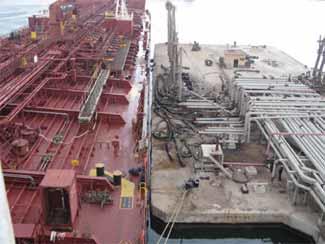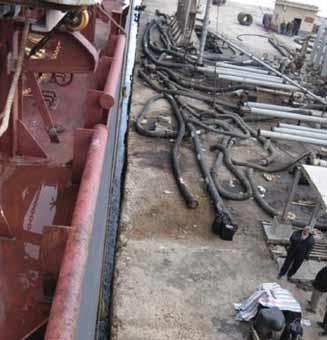200828 Unsafe tanker berth
Our medium-sized tanker recently called at a well-known oil terminal, where we were to berth starboard side to a finger pier. Approaching the berth, I noticed that there appeared to be only three small fenders on the foremost part, and the remaining length of the concrete wall had no protection at all (see pictures). Moreover, the ship being longer than the pier, there would be a 30-40 m overhang forward, with no suitable bollards for the forward breastlines or headlines, which would, at best, lead astern. I considered it an unsafe berth and after verbally protesting to the pilot and the port authorities, I refused to berth there.


However, the local regulations required that the vessel be cleared inwards, for which my ship had to tie up temporarily at this berth. We put out the few small rope fenders that we had and went alongside - during our short stay, I managed to photograph the berth. After obtaining inward clearance, we unberthed and anchored in the waiting area. Both my owners and time-charterers fully supported my decision not to conduct operations at this unsafe berth.
The following day, I was offered an alternative berth across the dock, which I was assured, was adequate in all respects. We berthed without incident and commenced cargo operations.
During our stay, another tanker came for loading at the berth that we had rejected earlier. We observed that the incoming vessel, too, had deployed some small rope fenders and proceeded to berth and conduct cargo operations.
It sometimes appears that a 'safety culture' is intended to be enforced only on ships and not on shore facilities. I may read aloud from the International Safety Guide for Oil Tankers and Terminals (ISGOTT) to ship's staff every day as a part of safety training but too often, life, property, security and the environment are put at risk because terminals ignore regulations and best practice.
Editor's note: While not a factor in this report, readers should also be aware that in certain countries, it is common for the terminal or the port authorities to slap an exorbitant damage claim on a vessel after she has carefully tied up at an obviously poorly fendered and previously damaged berth. In one such port, the authorities were seen to carry multiple photocopies of the partly-filled claim notice, leaving the date and the vessel name sections deliberately blank for convenience. Needless to say, the claim would be served on every berthing vessel only to be ceremoniously destroyed after the officials had extorted sufficient 'presents' from the master.
If obliged to berth under such circumstances, masters, especially those on tankers, should take all seamanlike precautions and additionally preserve photographs and other evidence, note protest and inform owners, charterers and the local P&I correspondent.
